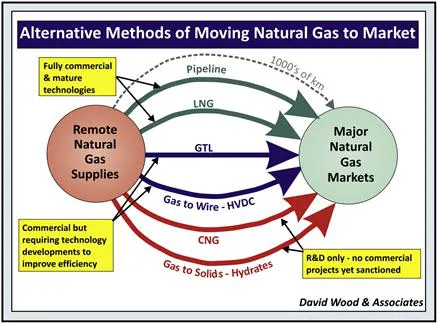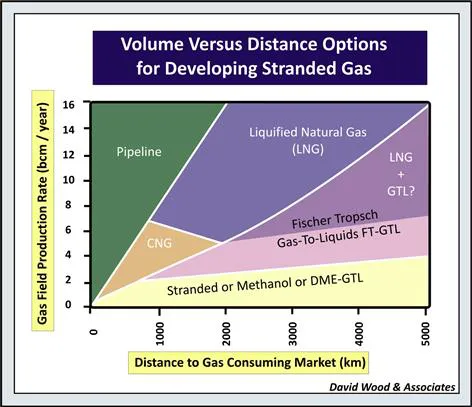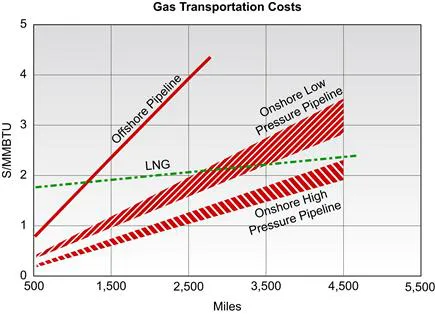
eBook - ePub
Handbook of Liquefied Natural Gas
- 624 pages
- English
- ePUB (mobile friendly)
- Available on iOS & Android
eBook - ePub
Handbook of Liquefied Natural Gas
About this book
Liquefied natural gas (LNG) is a commercially attractive phase of the commodity that facilitates the efficient handling and transportation of natural gas around the world. The LNG industry, using technologies proven over decades of development, continues to expand its markets, diversify its supply chains and increase its share of the global natural gas trade. The Handbook of Liquefied Natural Gas is a timely book as the industry is currently developing new large sources of supply and the technologies have evolved in recent years to enable offshore infrastructure to develop and handle resources in more remote and harsher environments. It is the only book of its kind, covering the many aspects of the LNG supply chain from liquefaction to regasification by addressing the LNG industries' fundamentals and markets, as well as detailed engineering and design principles. A unique, well-documented, and forward-thinking work, this reference book provides an ideal platform for scientists, engineers, and other professionals involved in the LNG industry to gain a better understanding of the key basic and advanced topics relevant to LNG projects in operation and/or in planning and development.
- Highlights the developments in the natural gas liquefaction industries and the challenges in meeting environmental regulations
- Provides guidelines in utilizing the full potential of LNG assets
- Offers advices on LNG plant design and operation based on proven practices and design experience
- Emphasizes technology selection and innovation with focus on a "fit-for-purpose design
- Updates code and regulation, safety, and security requirements for LNG applications
Frequently asked questions
Yes, you can cancel anytime from the Subscription tab in your account settings on the Perlego website. Your subscription will stay active until the end of your current billing period. Learn how to cancel your subscription.
No, books cannot be downloaded as external files, such as PDFs, for use outside of Perlego. However, you can download books within the Perlego app for offline reading on mobile or tablet. Learn more here.
Perlego offers two plans: Essential and Complete
- Essential is ideal for learners and professionals who enjoy exploring a wide range of subjects. Access the Essential Library with 800,000+ trusted titles and best-sellers across business, personal growth, and the humanities. Includes unlimited reading time and Standard Read Aloud voice.
- Complete: Perfect for advanced learners and researchers needing full, unrestricted access. Unlock 1.4M+ books across hundreds of subjects, including academic and specialized titles. The Complete Plan also includes advanced features like Premium Read Aloud and Research Assistant.
We are an online textbook subscription service, where you can get access to an entire online library for less than the price of a single book per month. With over 1 million books across 1000+ topics, we’ve got you covered! Learn more here.
Look out for the read-aloud symbol on your next book to see if you can listen to it. The read-aloud tool reads text aloud for you, highlighting the text as it is being read. You can pause it, speed it up and slow it down. Learn more here.
Yes! You can use the Perlego app on both iOS or Android devices to read anytime, anywhere — even offline. Perfect for commutes or when you’re on the go.
Please note we cannot support devices running on iOS 13 and Android 7 or earlier. Learn more about using the app.
Please note we cannot support devices running on iOS 13 and Android 7 or earlier. Learn more about using the app.
Yes, you can access Handbook of Liquefied Natural Gas by Saeid Mokhatab,John Y. Mak,Jaleel V. Valappil,David Wood,David A. Wood in PDF and/or ePUB format, as well as other popular books in Business & Natural Resource Extraction Industry. We have over one million books available in our catalogue for you to explore.
Information
Chapter 1
LNG Fundamentals
Abstract
Natural gas has remained the fastest growing energy resource in most regions of the world for more than two decades, driven by the low greenhouse gas emissions as well as high conversion efficiency in power generation. For almost a century, natural gas has been transported safely, reliably, and economically via pipeline. However, for the past decades it has become clear that significant quantities of new gas reserves are not so conveniently located. Attention has shifted to more isolated large gas reservoirs that were previously thought to be too remote, or technically too difficult and costly to develop. A number of solutions for exploiting stranded gas reserves are currently being developed and considered for commercialization. On the other hand, over the past three decades, only the liquefied natural gas (LNG) industry has successfully brought many large remote gas fields to the gas markets that are unreachable by pipeline (e.g., Japan, South Korea). This chapter briefly summarizes the components of the LNG supply chain—the steps and industrial processes used in producing, storing, and delivering LNG to commercial and residential customers.
Keywords
monetizing stranded gas; LNG characteristics; LNG supply chains; LNG environmental aspects; LNG facilities costs; LNG trade
1.1 Introduction
Natural gas has remained the fastest growing energy resource in most regions of the world for more than two decades, driven by the low greenhouse gas emissions as well as high conversion efficiency in power generation. For almost a century, natural gas has been transported safely, reliably, and economically via pipelines. Pipelines proved to be ideally suited to the supply and market conditions of the twentieth century, when large reservoirs of conventional natural gas are found in accessible locations. Pipelines provided the stability and security of supply and continue to do so where large accessible gas reserves remain. However, over the past decades it has become clear that significant quantities of new gas reserves are not so conveniently located. Attention has shifted to more isolated large gas reservoirs that were previously thought to be too remote, or technically too difficult and costly to develop. A number of solutions for exploiting stranded gas reserves are currently being developed and considered for commercialization. On the other hand, over the past three decades, only the liquefied natural gas (LNG) industry has successfully brought many large remote gas fields to the gas markets that are unreachable by pipeline (e.g., Japan, South Korea). Today, the LNG supply chains have diversified and introduced competition into markets previously “captured” by pipeline gas suppliers, and have improved the security of energy supply of many consuming nations and reduced the geopolitical and political constraints on global gas supply.
This chapter briefly summarizes the components of the LNG supply chain—the steps and industrial processes used in producing, storing, and delivering LNG to commercial and residential customers. For those readers new to the LNG industry and unfamiliar about what it is, how it is used, and its basic safety and environmental track record, Appendix 1 is included.
1.2 Monetizing stranded gas
Despite being one of the most abundant energy sources on the planet, more than one-third of global conventional natural gas reserves remain stranded (Thackeray and Leckie, 2002) and undeveloped. Growing global energy demand, diminishing oil resources, higher oil prices, the no-flaring regulations, and the benefits of lower greenhouse gas emissions from the burning of natural gas are leading to the urgency in the quest for commercially viable technologies for transporting stranded gas over long distances (Mokhatab and Wood, 2007a; Wood et al., 2008a).
Over the last two decades different technologies have been developed and proposed for monetizing hitherto remote gas reserves (see Figure 1-1). However, most of them are not fully matured to the extent for commercialization, and would require improvements in order to compete with existing technologies. On the other hand, selection of existing technologies is dependent on the distance to consumer markets and the gas field production rates (see Figure 1-2). Stranded gas is currently transported to markets primarily via two long-established technologies: some 70 percent of gas traded internationally is exported by pipeline; the remaining 30 percent by liquefied natural gas.

FIGURE 1-1 Technologies available to transport natural gas long distances. (Wood and Mokhatab, 2008a)

FIGURE 1-2 Production volume versus distance to market framework for gas technologies. (Wood & Mokhatab, 2008a; Wood et al., 2008a)
Figure 1-3 shows that LNG cost becomes competitive to pipeline gas for long-distance transport. As can be seen from Figure 1-3, for short distances, gas pipelines are usually more economical. LNG is competitive for long-distance routes, particularly those crossing oceans or long stretches of water, since construction of undersea pipelines is cost prohibitive (Mokhatab et al., 2006). For offshore stranded gas, LNG can be competitive when the offshore pipeline is less than 700 miles. For onshore pipelines, the breakeven point is about 2,200 miles (Mokhatab and Purewal, 2006).

FIGURE 1-3 Comparison of the cost of transporting gas via pipeline and LNG; for 1 tcf/yr and including regasification costs. (Mokhatab et al., 2006; Economides and Mokhatab, 2007)
When natural gas is cooled to approximately –162°C or –259°F at atmospheric pressure, the condensed liquid is LNG. The volume reduction is about 1/600th the volume of natural gas at the burner tip. The more condensed form of LNG allows transport using cargo ships or trucks. For long-distance transport, the gas pipeline option would require large diameter pipes and gas recompression facilities to overcome the transmission pressure drop, which are very costly.
The LNG option offers economics, flexibility, and security of supply advantages over gas pipeline and other technology alternatives. Many countries in Europe and Asia are embracing LNG for these reasons, even though large volumes of gas from Russia, North Africa, and the Middle East could satisfy their domestic energy demands through existing and planned pipeline connections. Today, with the increase in gas supply from the nonconventional gases, export from North American to the Asian countries is imminent. The share of the international natural gas trade as LNG is expected to increase in the coming decades.
1.3 LNG characteristics
1.3.1 Basic properties
A basic knowledge of LNG must begin with an examination of its chemical and physical properties, which is a prerequisite for accurately assessing potential LNG safety hazards and risks.
The properties of LNG vary with its composition, which depends on the reservoir source of the original gas and its processing/fractionation history. While LNG is predominately methane (about 87 mole % to 99 mole %), its composition also includes other higher hydrocarbons, typically, the C2 to C4 and heavier, nitrogen and trace amounts of sulfur (less than 4 ppmv), and CO2 (50 ppmv; see Table 1-1).
Table 1-1
Typical Composition of LNG from Various Liquefaction Plants

(ILEX Energy Consulting, 2003)
LNG is an odorless, colorless, and noncorrosive cryogenic liquid at normal atmospheric pressure. When LNG is vaporized and used as natural gas fuel, it generates very low particle emissions and significantly lower carbon emissions than other hydrocarbon fuels. The combustion products from LNG contain almost no sulfur oxides and a low level of nitrogen oxides, which makes LNG a clean source of energy.
LNG is nontoxic. However, as with any gaseous materials, natural gas release from LNG can cause asphyxiation due to lack of oxygen in an unventilated, confined area, and can be ignited if mixed with the right concentrations of air.
The boiling point of LNG varies with its composition, typically –162°C (–259°F). The density of LNG typically falls between 430 kg/m3and 470 kg/m3 (3.5 to 4 lb/US gal), which is less than half the density of water. LNG, if spilled on water, floats on top and vaporizes rapidly because it is much lighter than water. Initially LNG vapors are heavier than air and will stay near ground level. However as LNG vapors begin to be warmed up by the surroundings and reach temperatures of approximately –166°F, the density of the vapors is lighter than air and the vapors become buoyant. Cold LNG vapors (below –166°F) are more likely to accumulate in low areas until the vapors warm up. A release of LNG in an enclosed space or low spot will tend to displace air, making the area hazardous for breathing.
Vapors released from LNG, if not contained, will mix with surrounding air and will be carried downwind, which may create a vapor cloud that may become flammable and explosive. The flammability limits are 5 percent and 15 percent by volume in air. Outside of this range, the methane/air mixture is not flammable.
When fuel concentration exceeds its upper flammability limit, it cannot burn because too little oxygen is present. This situation exists, for example, in a closed, secure storage tank where the vapor concentration is approximately 100 percent methane. When fuel concentration is below the lower flammability limit, it cannot burn because too ...
Table of contents
- Cover image
- Title page
- Table of Contents
- Copyright
- Dedication
- Authors’ Biographical Sketches
- Contributors
- Preface
- Endorsements
- Chapter 1. LNG Fundamentals
- Chapter 2. Gas Conditioning and NGL Recovery Technologies
- Chapter 3. Natural Gas Liquefaction
- Chapter 4. Energy and Exergy Analyses of Natural Gas Liquefaction Cycles
- Chapter 5. Natural Gas Liquefaction Cycle Enhancements and Optimization
- Chapter 6. Process Control and Automation of LNG Plants and Import Terminals
- Chapter 7. LNG Plant and Regasification Terminal Operations
- Chapter 8. Dynamic Simulation and Optimization of LNG Plants and Import Terminals
- Chapter 9. LNG Safety and Security Aspects
- Chapter 10. Advances and Innovations in LNG Industry
- Chapter 11. LNG Project Management
- Appendix 1. An LNG Primer: Basic Facts, Safety and Security Clarifications
- Appendix 2. Modeling the Phase Behavior of LNG Systems with Equations of State
- Appendix 3. LNG Plant Relief and Flare Systems Design Guideline
- Index